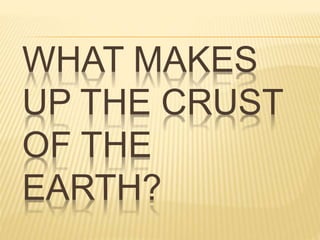
Minerals
- 1. WHAT MAKES UP THE CRUST OF THE EARTH?
- 2. MINERALS Minerals are naturally occurring substances that build up the Earth’s Crust. Minerals are made up of different Ions bonded together. Ions are charged atoms. Cations are positive ions and Anions are negative ions. Some common Cations are Si, Al, Fe, Ca, Na, K and Mg while anions are O and Cl.
- 3. CHARACTERISTICS OF MINERALS 1. Minerals are Solids. 2. Minerals are Made of Chemical Elements and Compounds. 3. Minerals have known Chemical composition. 4. Minerals are inorganic in nature.
- 4. Examples of Minerals 1. Hematite – make-up color 2. Chromite – Dyes 3. Copper – Electrical Wiring 4. Quartz – Clocks and Mirrors 5. Gold – Jewelries 6. Borax – Cleaner and antiseptic 7. Feldspar – Ceramics 8. Fluorite – toothpaste
- 5. CLASSIFICATION OF MINERALS - minerals can be classified based on their chemical compositions and physical properties. 1. Silicate minerals are those that contain silicon and oxygen. They further classified into “malfic silicates” and “felsic silicates”. a. Malfic silicates generally contain Fe or Mg and are dark in color. Examples; Olivine, Pyroxene, Amphibole and Biotite mica. b. Felsic Silicate contains K, Na and Al and
- 6. Malfic silicates - silicates that are dark in color. Examples; Olivine, Pyroxene, Amphibole and Biotite mica.
- 7. Felsic Silicate – silicate that are light in color. Examples; feldspar, quartz, clay minerals, and muscovite.
- 8. 2. Non Silicate minerals are those that do not contain silicon. The most common group of non silicate minerals are carbonates, halides and sulfates. Ex. Iodide, fluoride and sodium chloride.
- 9. 3. Metallic minerals are those that are made up of heavy metallic elements. Examples; copper, iron, gold, silver, chromium and nickel.
- 10. 4. Non metallic minerals lack the properties of the metallic minerals, such as bright metallic luster, hardness, density and good conductor of heat and electricity. Examples; calcite, quartz, talc and gypsum.
- 11. 5. Gem minerals are those that possess unique bright colors and commonly used for jewelry. Examples; jade, sapphire, ruby, opal and garnet.
- 12. INDENTIFICATION OF MINERALS Physical Properties of Minerals 1. Habit refers to the overall shape or growth pattern of the mineral. Scientists use “equant” “elongate” and “platy” to describe the habit of minerals: a. Equant – three dimensions of the mineral have about the same length, like that of a cube or sphere. Ex, Garnet shows an equant habit b. Elongate – minerals form prismatic or prism-like crystals that are thicker than needles as in a pencil. Ex, Indicolite shows an elongated habit. c. Platy – the minerals looks like a flattened and thin crystal (like Plates) Ex, Wulfenite shows a platy
- 13. 2. Luster – refers to the quality of light reflected from the exterior surface of the mineral. The Luster Minerals can be Opaque, Transparent, Dull, or Shiny. Metallic luster is Opaque and very reflective. Non metallic luster is Dull, Silky, greasy and pearly. 3. Breakage of the Minerals; are classified into; Cleavage – refer to the tendency of mineral to break along very smooth, flat and shiny surfaces. Fracture – the tendency of the mineral to break
- 14. MOH’S SCALE OF HARDNESS SCALE MINERALS 1 TALC 2 GYPSUM 2.5 FINGERNAIL 3 CALCITE 3.5 COPPER PENNY 4 FLUORITE 5 APATITE 5.5 STEEL KNIFE BLADE / GLASS PLATE 6 ORTHOCLASE FELDSPAR 7 QUARTZ 8 TOPAZ 9 CORUNDUM (RUBY) 10 DIAMOND
- 15. 4. Hardness – is a measure of the mineral’s resistance to Scratching. Harder minerals scratch softer minerals. Mohs’ Scale of Hardess was created by Minerologist Friedrich Mohs in 1812. 5. Color varies in many minerals making it very unreliable to set as a standard for identification. Some minerals comes in just one color, while others come in many colors and varieties. 6. Streak – refers to color of mark or powder left by rubbing the mineral against a streak plate (unglazed porcelain).